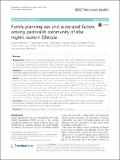| dc.identifier.citation | Alemayehu, M., Lemma, H., Abrha, K. et al. Family planning use and associated factors among pastoralist community of afar region, eastern Ethiopia. BMC Women's Health 16, 39 (2016). https://doi.org/10.1186/s12905-016-0321-7 | en_US |
| dc.description.abstract | Background: Ethiopia is the second most populous country in Africa with a total fertility rate (TFR) of 4.8 childrenper a woman and contraceptive prevalence rate (CPR) of 29 %. The overall prevalence of modern family planningin a pastoralist community, like Afar region, is low (9.1 %). This study aimed to assess family planning utilizationand associated factors among married women of Afar region, Eastern Ethiopia.Methods: A community-based cross-sectional study was conducted from January 10-28, 2013 among 602 women.Multistage sampling technique was used to select the study participants. Descriptive and multiple variable logisticregression analyses were done to isolate independent predictors on utilization of family planning using SPSS 20.Results: The overall prevalence of family planning utilization in Afar region was 8.5 % (6.2–10.7). Majority of thewomen (92.2 %) had used injectable. The most common reasons mentioned in the non-use of family planningmethods were religion-related (85.3 %), desire to have more children (75.3 %), and husband's objection (70.1 %).Women who had a positive attitude towards family planning utilization (AOR = 4.7, 95 % CI: 2.1, 10.3), owning radio(AOR = 1.8, 95 % CI: 1.02, 4.18), and literate (AOR = 4.4, 95 % CI: 1.80, 11.08) were more likely to use family planningmethods as compared to their counterparts. The increase of monthly income was also associated with the likelihoodof family planning methods utilization. The odds of using family planning methods were higher among those withmonthly income of $27–$55.5 (AOR = 2. 0, 95 % CI: 1.9, 4.7) and > $55 (AOR = 4. 6, 95 % CI: 1.23–17.19) as compared towomen with the lowest category of monthly income ($27 and less).Conclusion: The low coverage of family planning in the region could be due to the influence of husband, religiousand clan leader.Attitude of women towards family planning methods, possession of radio, monthly income, andeducational status could influence family planning utilization.Keywords: Afar, Family planning, Utilization, Ethiopia, Pastoralist community | en_US |

